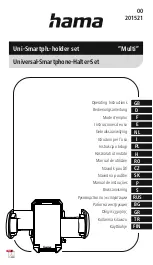
White paper
Sony Ericsson P1
39
May 2007
Synchronization
Fast synchronization, even without line of sight, of
calendar, notes and phonebook with computer.
Business cards
Quick exchange of business cards, notes and
calendar events with other phones and devices.
Imaging and music
Exchange still images and video clips with another
mobile phone, a computer, or with a digital still or
motion video camera. Use Sony Ericsson P1 as a
modem to send pictures from a digital camera to
an imaging server.
Exchange music files with another mobile phone or
a computer. Play MP3 and MIDI files sent by the
phone.
Enable images to be shown on a TV or other
display via an accessory, such as the Bluetooth™
Media Viewer MMW-100.
Audio quality
Sony Ericsson P1 uses an algorithm that repairs
lost audio packets. When needed, a new packet is
inserted with content based on previous packets.
This, in conjunction with the high sensitive and high
output power radio will enhance the audio quality
compared to a standard Bluetooth device.
File sharing
By using the server role of the File Transfer Profile,
the phone enables the user to use a computer to
manage content files that reside in the phone’s file
system or on a Memory Stick Micro™ (M2™). Most
computer Bluetooth applications provide an
explorer like user interface for the file transfer
service. When connecting to the phone, the
computer application will show one folder for the
content in the phone’s file system and another
folder for the content on the Memory Stick Micro™
(M2™). The content in the Games and more folder
is not exposed in the file transfer server. Opening
one of the folders will show a list of files related to
that folder, such as, images in the Pictures folder.
Using the computer application the user can now:
retrieve files from phone to computer, delete files
from the phone and transfer files from the
computer to the phone using the normal drag and
drop mechanisms provided by the computer.
File browsing
By using the client role of the File Transfer Profile,
the phone enables the user to access file systems
of other devices, that support the server role of the
same profile. After pairing the phone with the other
device, the user can connect to the other device by
selecting it in the list of My devices under the
Bluetooth menu and selecting the Browse option
that should be available on the left selection key. If
the browse option does not appear the user can
select the Service option to update the phone’s
knowledge that file browsing is possible with this
device. When the phone is connected to the file
server, the user can browse the shared folders and
retrieve files listed in the folders. The user can
transfer files to the file server device using the
normal Send/via Bluetooth option.
Media viewing
The phone can send images and sounds to a
media viewer device, such as, the MMW-100 TV
adaptor accessory. The user can also conveniently
run a slide show on the TV showing a set of nice
phone camera pictures for family and friends. The
phone can connect to a Bluetooth device that can
receive images, the image can be transferred to the
remote screen and displayed.
Profiles
The following Bluetooth profiles are supported in
Sony Ericsson P1:
• Dial-up Networking Profile
• Generic Access Profile
• Generic Object Exchange Profile
• Object Push Profile
• Serial Port Profile
• Handsfree Profile
• Headset Profile
• Synchronization Profile
• Basic Imaging Profile
• File Transfer Profile
• Human Interface Device (HID) host only Profile
• Stereo Advanced Audio Distribution Profile
√
^Çî~åÅÉÇ=^ìÇáçLsáÇÉç=oÉãçíÉ=`çåÑÉêÉåÅÉ=
mêçÑáäÉ
















































